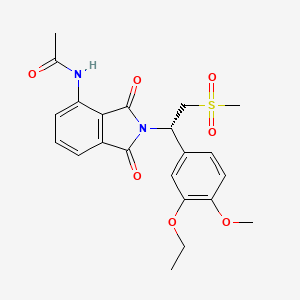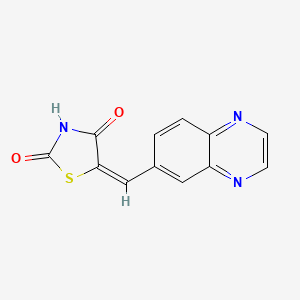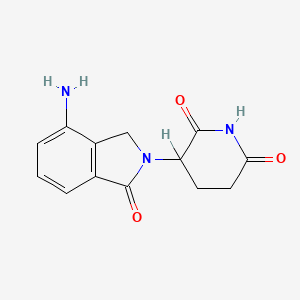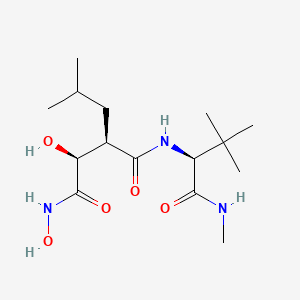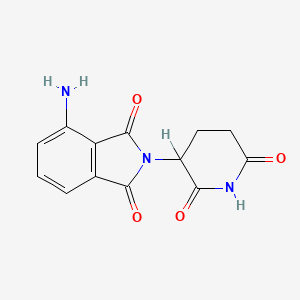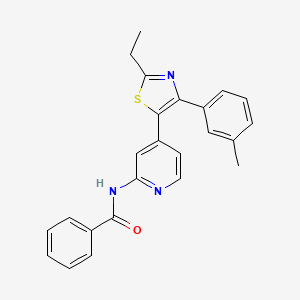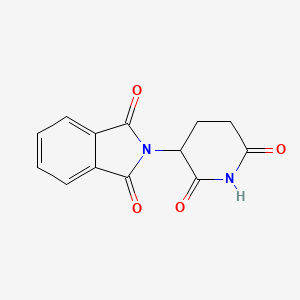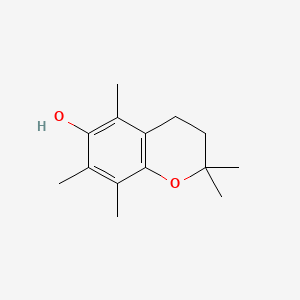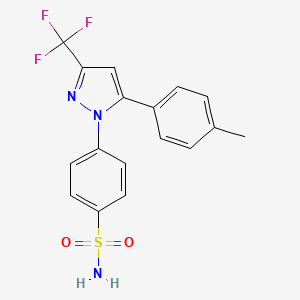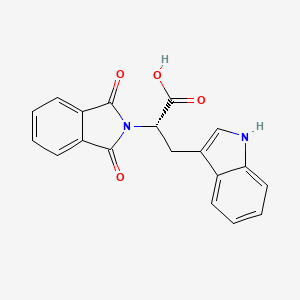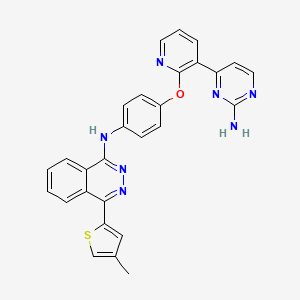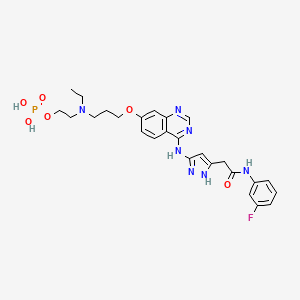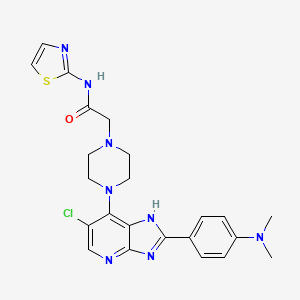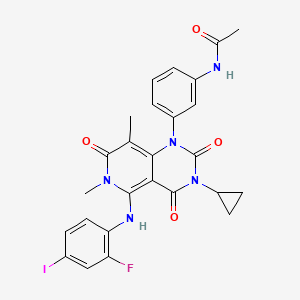
Trametinib
Overview
Description
Trametinib is an orally bioavailable mitogen-activated protein kinase (MAPK) kinase (MEK) inhibitor with antineoplastic activity. It specifically binds to MEK1 and MEK2, resulting in the inhibition of growth factor-mediated cell signaling and cellular proliferation in various cancers . This compound is primarily used for the treatment of unresectable or metastatic melanoma with BRAF V600E or V600K mutations .
Mechanism of Action
Target of Action
Trametinib is a kinase inhibitor that primarily targets mitogen-activated extracellular signal-regulated kinase 1 (MEK1) and MEK2 . These kinases play a crucial role in the MAPK/ERK pathway , which is involved in cell proliferation, survival, differentiation, and angiogenesis .
Mode of Action
This compound functions as an allosteric, ATP non-competitive inhibitor . It binds to unphosphorylated MEK1 and MEK2 with high affinity, blocking their catalytic activity . This inhibition prevents the phosphorylation and activation of MEKs, thereby suppressing downstream ERK signaling .
Biochemical Pathways
The primary biochemical pathway affected by this compound is the RAS/RAF/MEK/ERK pathway . This pathway transduces signals from various extracellular stimuli, leading to distinct intracellular responses . This compound’s inhibition of MEK1 and MEK2 disrupts this pathway, reducing the proliferation and survival of tumor cells .
Pharmacokinetics
This compound is orally bioavailable . Following oral administration, over 80% of excreted radioactivity was recovered in the feces, while less than 20% was recovered in the urine, with less than 0.1% of the excreted dose as the parent molecule . This suggests that this compound is primarily eliminated via fecal excretion.
Result of Action
This compound’s action results in a decrease in cell proliferation and an increase in apoptosis . It has been shown to induce G1 cell cycle arrest in vitro . Additionally, this compound significantly decreases macrophage infiltration and the expression of pro-inflammatory cytokines in the kidneys . It also lowers lipid peroxidation by-products, restores the reduced glutathione/oxidized glutathione ratio, and downregulates NADPH oxidase 4 .
Action Environment
The efficacy of this compound can be influenced by environmental factors such as patient adherence to the medication regimen . Poor adherence can result in suboptimal drug exposure and consequently unfavorable patient outcomes . Therefore, ensuring patient adherence to this compound is crucial for its therapeutic success.
Biochemical Analysis
Biochemical Properties
Trametinib specifically binds to MEK1 and MEK2, resulting in inhibition of growth factor-mediated cell signaling and cellular proliferation in various cancers . It is a reversible, highly selective, allosteric inhibitor of MEK1 and MEK2 . By binding to unphosphorylated MEK1 and MEK2 with high affinity, this compound blocks the catalytic activity of MEKs .
Cellular Effects
This compound has been shown to inhibit the proliferation, migration, and invasion of glioma cells, while inducing apoptosis of glioma cells . It can suppress both the expression of PKM2 in glioma cells and the transport of PKM2 into the cellular nucleus via suppression of ERK1/2 expression . This compound also significantly reduces the phosphorylation of MEK1/2 and extracellular signal-regulated kinase 1/2 (ERK1/2), mitigated renal dysfunction, and ameliorated histopathological abnormalities .
Molecular Mechanism
This compound is a kinase inhibitor that inhibits cell growth of various BRAF V600 mutation-positive tumors in vitro and in vivo . It functions as an allosteric, ATP noncompetitive inhibitor with nanomolar activity against both MEK 1 and MEK 2 kinases . It maintains MEK in an unphosphorylated form, preventing phosphorylation and activation of MEKs .
Temporal Effects in Laboratory Settings
This compound has been shown to have significant effects over time in laboratory settings. For instance, it has been found that this compound can inhibit the growth and intracellular glycolysis of glioma cells by targeting the PKM2/c-Myc pathway . Moreover, this compound treatment accelerated disease onset and decreased epidermal thickness, which was in large part ameliorated by Losartan treatment .
Dosage Effects in Animal Models
The effects of this compound vary with different dosages in animal models. For instance, this compound has been shown to significantly enhance remyelination in both MOG-induced EAE model and LPC-induced focal demyelination model . Furthermore, this compound has been shown to inhibit the growth of the transplanted glioma cell tumor .
Metabolic Pathways
This compound is involved in the MAPK pathway, which plays a critical role in cell growth, differentiation, inflammation, and apoptosis . Mutant BRAF proteins signal through MEK1 and MEK2, stimulating cell growth . This compound is metabolized predominantly via deacetylation followed by oxidation and/or glucuronidation .
Transport and Distribution
This compound has limited brain distribution due to active efflux at the blood-brain barrier (BBB) . Following administration, this compound and its metabolites are excreted in the feces (≥81%) and to a minor extent in urine (≤19%) .
Subcellular Localization
This compound is mainly localized in the cytoplasm . It has been shown that this compound can suppress both the expression of PKM2 in glioma cells and the transport of PKM2 into the cellular nucleus via suppression of ERK1/2 expression .
Preparation Methods
Synthetic Routes and Reaction Conditions
The synthesis of trametinib involves several key steps. The starting material is typically a substituted aniline, which undergoes a series of reactions including cyclization, acylation, and halogenation to form the final product . The reaction conditions often involve the use of organic solvents such as dimethyl sulfoxide and reagents like thionyl chloride .
Industrial Production Methods
In industrial settings, the production of this compound is scaled up using similar synthetic routes but with optimized reaction conditions to ensure high yield and purity. The process involves rigorous quality control measures to monitor the formation of impurities and ensure the final product meets regulatory standards .
Chemical Reactions Analysis
Types of Reactions
Trametinib undergoes various chemical reactions, including:
Oxidation: This compound can be oxidized under certain conditions, leading to the formation of degradation products.
Reduction: Reduction reactions can also occur, although they are less common.
Substitution: Substitution reactions, particularly involving halogen atoms, are a key part of the synthetic process.
Common Reagents and Conditions
Oxidation: Common oxidizing agents include hydrogen peroxide and potassium permanganate.
Reduction: Reducing agents such as sodium borohydride can be used.
Substitution: Halogenation reagents like thionyl chloride are commonly used.
Major Products Formed
The major products formed from these reactions include various intermediates and impurities, such as desacetyl this compound and cyclopropanamide impurity .
Scientific Research Applications
Trametinib has a wide range of scientific research applications:
Chemistry: It is used as a model compound in the study of kinase inhibitors and their mechanisms of action.
Biology: This compound is used to study cell signaling pathways, particularly the MAPK/ERK pathway.
Industry: This compound is used in the pharmaceutical industry for the development of new cancer therapies.
Comparison with Similar Compounds
Similar Compounds
Cobimetinib: Another MEK inhibitor used in combination with vemurafenib for the treatment of melanoma.
Selumetinib: A MEK inhibitor used for the treatment of neurofibromatosis type 1.
Uniqueness of Trametinib
This compound is unique in its ability to selectively inhibit both MEK1 and MEK2 with high potency . It has shown significant efficacy in combination with BRAF inhibitors, such as dabrafenib, for the treatment of BRAF-mutant cancers . This combination therapy has been shown to provide greater and more prolonged inhibition of tumor growth compared to either drug alone .
Properties
IUPAC Name |
N-[3-[3-cyclopropyl-5-(2-fluoro-4-iodoanilino)-6,8-dimethyl-2,4,7-trioxopyrido[4,3-d]pyrimidin-1-yl]phenyl]acetamide | |
|---|---|---|
| Source | PubChem | |
| URL | https://pubchem.ncbi.nlm.nih.gov | |
| Description | Data deposited in or computed by PubChem | |
InChI |
InChI=1S/C26H23FIN5O4/c1-13-22-21(23(31(3)24(13)35)30-20-10-7-15(28)11-19(20)27)25(36)33(17-8-9-17)26(37)32(22)18-6-4-5-16(12-18)29-14(2)34/h4-7,10-12,17,30H,8-9H2,1-3H3,(H,29,34) | |
| Source | PubChem | |
| URL | https://pubchem.ncbi.nlm.nih.gov | |
| Description | Data deposited in or computed by PubChem | |
InChI Key |
LIRYPHYGHXZJBZ-UHFFFAOYSA-N | |
| Source | PubChem | |
| URL | https://pubchem.ncbi.nlm.nih.gov | |
| Description | Data deposited in or computed by PubChem | |
Canonical SMILES |
CC1=C2C(=C(N(C1=O)C)NC3=C(C=C(C=C3)I)F)C(=O)N(C(=O)N2C4=CC=CC(=C4)NC(=O)C)C5CC5 | |
| Source | PubChem | |
| URL | https://pubchem.ncbi.nlm.nih.gov | |
| Description | Data deposited in or computed by PubChem | |
Molecular Formula |
C26H23FIN5O4 | |
| Source | PubChem | |
| URL | https://pubchem.ncbi.nlm.nih.gov | |
| Description | Data deposited in or computed by PubChem | |
DSSTOX Substance ID |
DTXSID901007381 | |
| Record name | N-{3-[3-Cyclopropyl-5-(2-fluoro-4-iodoanilino)-6,8-dimethyl-2,4,7-trioxo-3,4,6,7-tetrahydropyrido[4,3-d]pyrimidin-1(2H)-yl]phenyl}ethanimidic acid | |
| Source | EPA DSSTox | |
| URL | https://comptox.epa.gov/dashboard/DTXSID901007381 | |
| Description | DSSTox provides a high quality public chemistry resource for supporting improved predictive toxicology. | |
Molecular Weight |
615.4 g/mol | |
| Source | PubChem | |
| URL | https://pubchem.ncbi.nlm.nih.gov | |
| Description | Data deposited in or computed by PubChem | |
Mechanism of Action |
Trametinib is a reversible, allosteric inhibitor of mitogen-activated extracellular signal regulated kinase 1 _(MEK1)_ and _MEK2_ activation and of_ MEK1_ and _MEK2_ kinase activity. MEK proteins are upstream regulators of the extracellular signal-related kinase (ERK) pathway, which promotes cellular proliferation. Trametinib helps with melanoma with the BRAF V600E or V600K as the mutation results in the constitutive activation of the BRAF pathway which includes MEK1 and MEK2. | |
| Record name | Trametinib | |
| Source | DrugBank | |
| URL | https://www.drugbank.ca/drugs/DB08911 | |
| Description | The DrugBank database is a unique bioinformatics and cheminformatics resource that combines detailed drug (i.e. chemical, pharmacological and pharmaceutical) data with comprehensive drug target (i.e. sequence, structure, and pathway) information. | |
| Explanation | Creative Common's Attribution-NonCommercial 4.0 International License (http://creativecommons.org/licenses/by-nc/4.0/legalcode) | |
CAS No. |
871700-17-3 | |
| Record name | Trametinib | |
| Source | CAS Common Chemistry | |
| URL | https://commonchemistry.cas.org/detail?cas_rn=871700-17-3 | |
| Description | CAS Common Chemistry is an open community resource for accessing chemical information. Nearly 500,000 chemical substances from CAS REGISTRY cover areas of community interest, including common and frequently regulated chemicals, and those relevant to high school and undergraduate chemistry classes. This chemical information, curated by our expert scientists, is provided in alignment with our mission as a division of the American Chemical Society. | |
| Explanation | The data from CAS Common Chemistry is provided under a CC-BY-NC 4.0 license, unless otherwise stated. | |
| Record name | Trametinib [USAN:INN] | |
| Source | ChemIDplus | |
| URL | https://pubchem.ncbi.nlm.nih.gov/substance/?source=chemidplus&sourceid=0871700173 | |
| Description | ChemIDplus is a free, web search system that provides access to the structure and nomenclature authority files used for the identification of chemical substances cited in National Library of Medicine (NLM) databases, including the TOXNET system. | |
| Record name | Trametinib | |
| Source | DrugBank | |
| URL | https://www.drugbank.ca/drugs/DB08911 | |
| Description | The DrugBank database is a unique bioinformatics and cheminformatics resource that combines detailed drug (i.e. chemical, pharmacological and pharmaceutical) data with comprehensive drug target (i.e. sequence, structure, and pathway) information. | |
| Explanation | Creative Common's Attribution-NonCommercial 4.0 International License (http://creativecommons.org/licenses/by-nc/4.0/legalcode) | |
| Record name | N-{3-[3-Cyclopropyl-5-(2-fluoro-4-iodoanilino)-6,8-dimethyl-2,4,7-trioxo-3,4,6,7-tetrahydropyrido[4,3-d]pyrimidin-1(2H)-yl]phenyl}ethanimidic acid | |
| Source | EPA DSSTox | |
| URL | https://comptox.epa.gov/dashboard/DTXSID901007381 | |
| Description | DSSTox provides a high quality public chemistry resource for supporting improved predictive toxicology. | |
| Record name | N-{3-[3-cyclopropyl-5-[(2-fluoro-4-iodophenyl)amino]-6,8-dimethyl-2,4,7-trioxo-3,4,6,7-tetrahydropyrido[4,3-d]pyrimidin-1(2H)-yl]phenyl}acetamide | |
| Source | European Chemicals Agency (ECHA) | |
| URL | https://echa.europa.eu/information-on-chemicals | |
| Description | The European Chemicals Agency (ECHA) is an agency of the European Union which is the driving force among regulatory authorities in implementing the EU's groundbreaking chemicals legislation for the benefit of human health and the environment as well as for innovation and competitiveness. | |
| Explanation | Use of the information, documents and data from the ECHA website is subject to the terms and conditions of this Legal Notice, and subject to other binding limitations provided for under applicable law, the information, documents and data made available on the ECHA website may be reproduced, distributed and/or used, totally or in part, for non-commercial purposes provided that ECHA is acknowledged as the source: "Source: European Chemicals Agency, http://echa.europa.eu/". Such acknowledgement must be included in each copy of the material. ECHA permits and encourages organisations and individuals to create links to the ECHA website under the following cumulative conditions: Links can only be made to webpages that provide a link to the Legal Notice page. | |
| Record name | TRAMETINIB | |
| Source | FDA Global Substance Registration System (GSRS) | |
| URL | https://gsrs.ncats.nih.gov/ginas/app/beta/substances/33E86K87QN | |
| Description | The FDA Global Substance Registration System (GSRS) enables the efficient and accurate exchange of information on what substances are in regulated products. Instead of relying on names, which vary across regulatory domains, countries, and regions, the GSRS knowledge base makes it possible for substances to be defined by standardized, scientific descriptions. | |
| Explanation | Unless otherwise noted, the contents of the FDA website (www.fda.gov), both text and graphics, are not copyrighted. They are in the public domain and may be republished, reprinted and otherwise used freely by anyone without the need to obtain permission from FDA. Credit to the U.S. Food and Drug Administration as the source is appreciated but not required. | |
Melting Point |
293-303 | |
| Record name | Trametinib | |
| Source | DrugBank | |
| URL | https://www.drugbank.ca/drugs/DB08911 | |
| Description | The DrugBank database is a unique bioinformatics and cheminformatics resource that combines detailed drug (i.e. chemical, pharmacological and pharmaceutical) data with comprehensive drug target (i.e. sequence, structure, and pathway) information. | |
| Explanation | Creative Common's Attribution-NonCommercial 4.0 International License (http://creativecommons.org/licenses/by-nc/4.0/legalcode) | |
Synthesis routes and methods I
Procedure details








Synthesis routes and methods II
Procedure details








Retrosynthesis Analysis
AI-Powered Synthesis Planning: Our tool employs the Template_relevance Pistachio, Template_relevance Bkms_metabolic, Template_relevance Pistachio_ringbreaker, Template_relevance Reaxys, Template_relevance Reaxys_biocatalysis model, leveraging a vast database of chemical reactions to predict feasible synthetic routes.
One-Step Synthesis Focus: Specifically designed for one-step synthesis, it provides concise and direct routes for your target compounds, streamlining the synthesis process.
Accurate Predictions: Utilizing the extensive PISTACHIO, BKMS_METABOLIC, PISTACHIO_RINGBREAKER, REAXYS, REAXYS_BIOCATALYSIS database, our tool offers high-accuracy predictions, reflecting the latest in chemical research and data.
Strategy Settings
| Precursor scoring | Relevance Heuristic |
|---|---|
| Min. plausibility | 0.01 |
| Model | Template_relevance |
| Template Set | Pistachio/Bkms_metabolic/Pistachio_ringbreaker/Reaxys/Reaxys_biocatalysis |
| Top-N result to add to graph | 6 |
Feasible Synthetic Routes
Disclaimer and Information on In-Vitro Research Products
Please be aware that all articles and product information presented on BenchChem are intended solely for informational purposes. The products available for purchase on BenchChem are specifically designed for in-vitro studies, which are conducted outside of living organisms. In-vitro studies, derived from the Latin term "in glass," involve experiments performed in controlled laboratory settings using cells or tissues. It is important to note that these products are not categorized as medicines or drugs, and they have not received approval from the FDA for the prevention, treatment, or cure of any medical condition, ailment, or disease. We must emphasize that any form of bodily introduction of these products into humans or animals is strictly prohibited by law. It is essential to adhere to these guidelines to ensure compliance with legal and ethical standards in research and experimentation.
